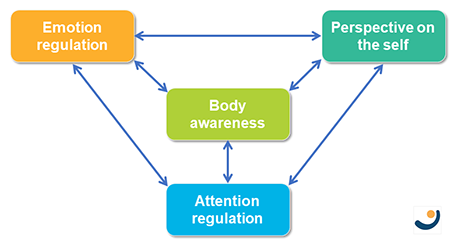Buddhist mindfulness practices have been around for more than 2500 years. Now, revamped in psychological, therapeutic and neuroscientific contexts, questions are asked how these practices actually work. Well, we are not talking about this from a Buddhist perspective. we are not asking how it may help individuals to reach a state of liberation or to even move on to enlightenment, but we want to see whether some of the processes that lead to beneficial outcomes can be described in psychological and neuroscientific terminology.
You may wonder if this is really needed? For a practitioner not necessarily – I would think. But as we see the practice of mindfulness becoming more and more woven into mainstream psychology a clear model that describes the underlying processes will be helpful for devising programmes that benefit those people who do not directly want to attend a Buddhist meditation centre. It will also help focusing the question whether such ‘psychological’ mindfulness programmes are really beneficial in improving lives.
Britta Hölzel with several colleagues from the Bender Institute of Neuroimaging in Giessen and from the Harvard Medical School in Boston just published a theoretical paper that outlines their ideas of some of the main mechanisms of mindfulness meditation. Building on previous work by Shauna Shapiro, by Bishop et al, and also by Baer et al. they suggest that the interplay of four components is at the core of mindfulness meditation. These four components are:
- Attention regulation
- Body awareness
- Emotion regulation
- Change in perspective on the self

A theoretical perspective of mechanisms of mindfulness
The authors developed their model on theoretical grounds and – to a varying degree – underpin the four main model components by referencing supporting empirical evidence. This evidence is treated in a rather coarse way, not distinguishing between different forms of meditation practice or intervention programmes and also not between studies that show direct evidence and others that are more indirect.
As the aim of the paper is to outline a theoretical model to be tested, rather than to make solid claims regarding the empirical support of every aspect of the model, this more general approach seems reasonable and a good way forward.
Furthermore, the model spells out some details that other discussions of the mechanisms underlying mindfulness practice have merely implied. It thus opens the door to more rigorous testing of these mechanisms.
Does it tell us how mindfulness meditation works?
So, does this paper fully answer the question how mindfulness meditation works? No, it certainly does not! – But it also does not claim to do so.
It rather provides a framework that may make it easier to position future research. Furthermore, it highlights the importance of considering various active components at the same time, rather than focusing on only one particular element.
The authors see the strength of their work in providing a model that considers mindfulness meditation practice as a process of enhanced self-regulation, consisting of the interplay of attention regulation, body awareness, emotion regulation (in form of reappraisal and extinction) and in a change of perspective regarding the self. While each of these components has previously been implicated in mindfulness practice, this model is the first to pull it all together in this way.
There is still much work to do and many questions are currently unanswered, for instance:
- The relevance of the different suggested components need to be determined empirically and their relationship and possible interactions needs to be defined. For instance, is body awareness a model component to be considered in its own right, or should it rather be understood as a specific type of attention training – focused attention on the body?
- The role of non-referential awareness, sometimes considered the pinnacle of mindfulness practice, does not yet feature strongly in this model.
- Different types of meditation need to be defined and distinguished more clearly, as it cannot be assumed that they all work in the same way or have the same effects.
- Active ingredients of comprehensive intervention programmes like mindfulness-based stress reduction (MBSR), need to be identified, before claims can be made that the mindfulness meditation that is part of these programmes is the deciding factor.
The list of questions could be much longer. But I will leave it at that.
So, this theoretical paper is a must read for everyone interested in how mindfulness meditation may lead to benefits, in particular for meditation researchers. It gives some important impulses for future research and waits to be refined and developed further.
Reference
Hölzel, B. K., Lazar, S. W., Gard, T., Schuman-Olivier, Z., Vago, D. R., & Ott, U. (2011). How does mindfulness meditation work? Proposing mechanisms of action from a conceptual and neural perspective. Perspectives on Psychological Science, 6(6), 537-559. https://doi.org/10.1177/1745691611419671



